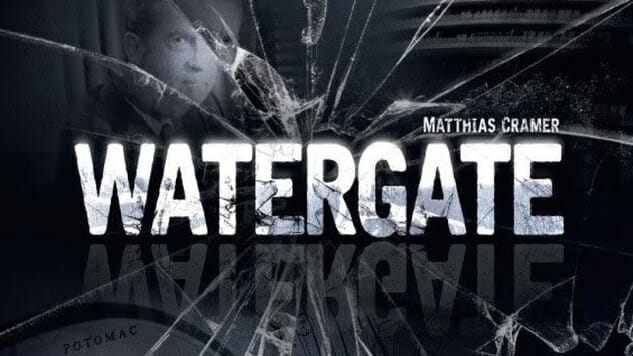The Watergate Board Game Is a Perfectly Timed Two-Player Treat

The President is besieged by reports of a scandal, and intrepid reporters are trying to uncover the details and get more members of his Administration to turn on him—perhaps enough to force him to resign. I’m talking about President Nixon and the efforts of the Washington Post in 1972-74, of course, but the spectacular new two-player game Watergate couldn’t have come out at a better time.
Designer Matthias Cramer, whose first title Glen More is an overlooked classic worker placement game, has managed to do something novel with hand management games by creating two decks that incorporate real people and events from the third-rate burglary attempt—a quote that Cramer uses as a card title—where each card also has two distinct uses. The cards have actual photos of the various witness and other events from the scandal, while the rulebook has an extensive appendix explaining the history and the specific roles the various people who appear in the game played in the break-in, the cover-up, and the eventual downfall of the President.
One player plays as Nixon, while the other plays the journalists, with each player playing with a unique deck, slightly distinct mechanics, and different victory conditions. (My daughter wanted to play as “the bad guy,” so she’s clearly aware of what’s going on in the world right now.) The board itself has seven major figures from the scandal around its perimeter and a photo of Tricky Dick himself in the center, with a web of spokes through spaces for evidence tokens. If the player playing as the journalists can create paths of face-up evidence tokens connecting any two witnesses to Nixon, they win the game; the player playing as Nixon will try to place evidence tokens face-down to block those routes.
The game’s turns involve a card-based fight for control of three evidence tokens drawn at random from the bag, a ‘momentum token’ handed out at the end of each turn, and the initiative token that determines the start player and gives that player one more card in the next turn. The research track has 11 spaces, five toward each player and the 0 space in the middle where all tokens (usually) begin. Every card in both players’ decks has a token movement function, showing a specific color of evidence token (green, blue, or yellow, with some wild cards as well) and a number of spaces that the token would move in that players’ direction. If you move a token all the way to your 5 spot, you simply get it; otherwise, when both players have played all of their cards, the round ends and each player gets the tokens on their side of the 0 space. The journalist places their evidence tokens face-up on the board; Nixon places their evidence tokens face-down, both only placing the tokens on spaces of the matching color. You can use your cards to move the momentum or initiative tokens instead of the evidence tokens.